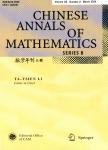Mathematical Analysis of the Jin-Neelin Model of El Niño-Southern-Oscillation
作者机构:Department of Mathematics and the Institute for Scientific Computing and Applied MathematicsIndiana University Department of Atmospheric and Oceanic SciencesUniversity of California
出 版 物:《Chinese Annals of Mathematics,Series B》 (数学年刊(B辑英文版))
年 卷 期:2019年第40卷第1期
页 面:1-38页
核心收录:
学科分类:07[理学] 0701[理学-数学] 070101[理学-基础数学]
基 金:supported by the Office of Naval Research Multidisciplinary University Research Initiative(No.N00014-16-1-2073) the National Science Foundation(Nos.OCE-1658357,DMS-1616981,DMS-1206438,DMS-1510249) the Research Fund of Indiana University
主 题:El Niño-Southern Oscillation Coupled nonlinear hyperbolic-parabolic systems Fractional step method Semigroup theory
摘 要:The Jin-Neelin model for the El Nio–Southern Oscillation(ENSO for short) is considered for which the authors establish existence and uniqueness of global solutions in time over an unbounded channel domain. The result is proved for initial data and forcing that are sufficiently small. The smallness conditions involve in particular key physical parameters of the model such as those that control the travel time of the equatorial waves and the strength of feedback due to vertical-shear currents and upwelling; central mechanisms in ENSO *** the mathematical view point, the system appears as the coupling of a linear shallow water system and a nonlinear heat equation. Because of the very different nature of the two components of the system, the authors find it convenient to prove the existence of solution by semi-discretization in time and utilization of a fractional step scheme. The main idea consists of handling the coupling between the oceanic and temperature components by dividing the time interval into small sub-intervals of length k and on each sub-interval to solve successively the oceanic component, using the temperature T calculated on the previous sub-interval, to then solve the sea-surface temperature(SST for short) equation on the current sub-interval. The passage to the limit as k tends to zero is ensured via a priori estimates derived under the aforementioned smallness conditions.



